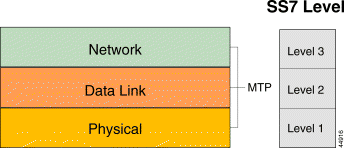|
|

This chapter describes the components of the SS7 protocol stack. A stack is a set of data storage locations that are accessed in a fixed sequence. The SS7 stack is compared against the Open Systems Interconnection (OSI) model for communication between different systems made by different vendors.
Figure 3-1 shows the components of the SS7 protocol stack.
This is the physical level of connectivity, virtually the same as Layer 1 of the OSI model. SS7 specifies what interfaces will be used, both Bellcore (Telecordia) and ANSI call for either the DS0A or the V.35 interface.
Because central offices are already using DS1 and DS3 facilities to link one another, the DS0A interface is readily available in all central offices, and is preferred in the SS7 network. As the demands on the SS7 network increase (local number portability), and as the industry migrates toward ATM networks, the DS1 interface will become the link interface.
Sequential numbering is used to determine if any messages have been lost during transmission. Each link uses its own message numbering series independent of other links.

Message distribution provides link, route and traffic management functions.
This function uses the Link Status Signal Unit (LSSU) to notify adjacent nodes of link problems. Level 3 will send LSSUs via Level 2 to the adjacent node, notifying it of the problems with the link and its status.
Diagnostics consists of realigning and resynchronizing the link.
Another form of link management uses changeover and changeback messages sent using Message Signal Units (MSUs). MSUs advise the adjacent node to send traffic over another link within the same linkset. The alternate link must be within the same linkset.
The bad link is being realigned by Level 3 while traffic is rerouted over alternate links. Changeback message is sent to advise the adjacent node that it can use the newly restored link again. Changeback messages are typically followed by a changeback acknowledgement message.
Route management informs other nodes of the status of the affected node. It uses Message Signal Units (MSUs) generated by adjacent nodes and is not usually generated by the affected nodes. (Link management only informs adjacent nodes.)
For example, if ISUP is not available at a particular node, a traffic management message can be sent to adjacent nodes informing them that ISUP is not available, without affecting TCAP messages on the same node.
Every SS7 node must have its own unique point code. Message routing determines the point code from an address contained in the routing table.
Protocols are used within the layers (levels) of the SS7 protocol to accomplish functions called for at each level. Levels 1, 2 and 3 are combined into one part, the Message Transfer Part (MTP). (See Figure 3-2.)
MTP provides the rest of the levels with node-to-node transmission, including basic error detection and correction schemes and message sequencing. It provides routing, message discrimination and distribution functions within a node.

Level 4 consists of several protocols, user parts and application parts. (See Figure 3-3.)

MAP (Mobile Application Part) is used to share cellular subscriber information among different networks. It includes information such as the mobile identification number (MIN), and the serial number of the cellular handset. This information is used by the IS-41 protocol during cellular roaming.
BISUP (Broadband ISUP) will gradually replace ISUP as ATM is deployed.
Broadband ISDN User Part (BISUP) is an ATM protocol intended to support services such as high-definition television (HDTV), multilingual TV, voice and image storage and retrieval, video conferencing, high-speed LANs and multimedia.
1. Define MTP and describe its components.
2. What is the preferred interface for MTP Level 1? Why?
3. How does the data link level (MTP Level 2) determine if any messages have been lost during transmission?
4. What method does MTP Level 2 use for error checking?
5. Identify three functions performed by message distribution.
6. What type of signal unit does link management use?
7. When a problem occurs with a link, which nodes does link management notify?
8. Identify the types of diagnostics available to link management.
9. What happens during the link alignment process?
10. FISUs are used for what function?
11. Define proving period.
12. What type of signal unit sends changeover and changeback messages?
13. Describe the function of a changeover message.
14. What is the expected response to a changeover message?
15. What is the function of route management?
16. Define flow control.
17. What does the message discrimination function do with non-local messages?
18. Define ISUP and describe its functions.
19. Define TCAP and describe its functions.
20. Define SCCP and describes its functions.
21. What are the differences between TUP, ISUP and BISUP?
![]()
![]()
![]()
![]()
![]()
![]()
![]()
![]()
Posted: Sat Sep 28 13:44:37 PDT 2002
All contents are Copyright © 1992--2002 Cisco Systems, Inc. All rights reserved.
Important Notices and Privacy Statement.